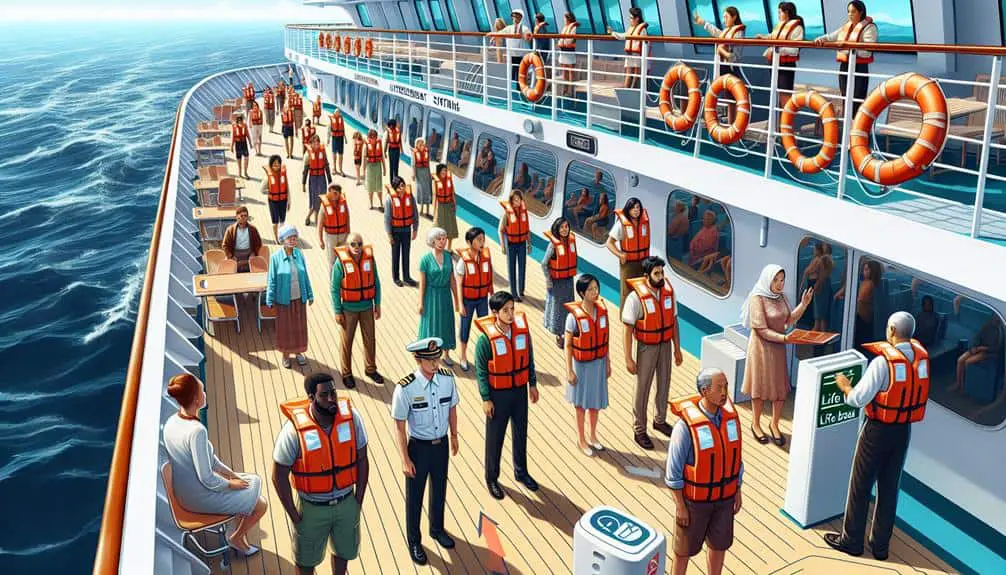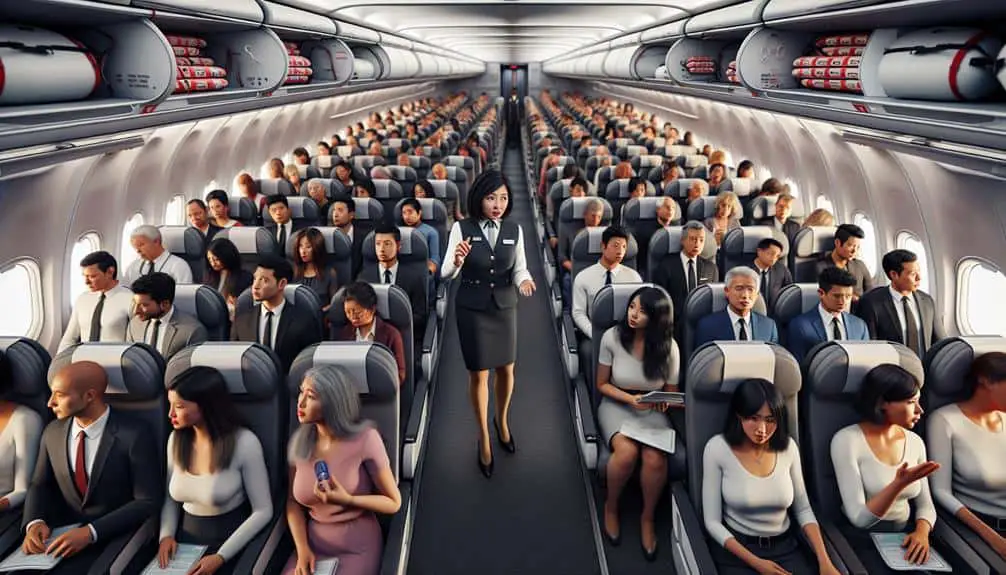Understanding why evacuation procedures are essential on cruise liners is important for your safety. Efficient procedures, training, and regular drills boost preparedness and confidence. Crew members play a crucial role in guiding passengers calmly during emergencies. Adherence to regulations guarantees safety standards are met. Passenger safety training and drills instill readiness and confidence. Technological innovations enhance evacuation systems for efficiency. Stay informed about the importance of these procedures to guarantee a safe cruising experience.
Key Points
- Evacuation procedures ensure passenger and crew safety during emergencies.
- Compliance with regulations and safety standards minimizes risks on cruise liners.
- Emergency response team readiness through regular training and drills is essential.
- Passenger safety training and drills prepare individuals for emergencies at sea.
- Technological innovations enhance efficiency and communication in evacuation processes.
Importance of Evacuation Procedures
Understanding the vital role of evacuation procedures is paramount for ensuring the safety of passengers and crew on cruise liners. Training effectiveness plays a pivotal role in preparing both passengers and crew for emergencies. Regular drills and simulations enhance familiarity with emergency protocols, ensuring that everyone knows their responsibilities and how to respond swiftly and effectively in high-stress situations.
Efficient training not only boosts confidence but also minimizes panic during emergencies. Crew members trained in evacuation procedures can guide passengers calmly and efficiently to designated assembly points. This training effectiveness is directly linked to the successful execution of emergency protocols. Clear communication and well-rehearsed procedures can make a significant difference in the outcome of an emergency situation.
Regulations and Safety Standards
To guarantee the safety of passengers and crew on cruise liners, adherence to established regulations and safety standards is imperative. Regulatory compliance plays a pivotal role in ensuring that cruise liners operate within the legal framework set forth by maritime authorities. These regulations encompass a wide range of safety measures, including requirements for life-saving equipment, emergency drills, and crew training. Cruise liners are expected to meet industry benchmarks in areas such as fire safety, navigation protocols, and emergency response procedures. By adhering to these standards, cruise operators demonstrate their commitment to maintaining a safe environment for everyone on board.
Industry benchmarks serve as a guide for cruise liners to continuously improve safety practices and emergency preparedness. Regular audits and inspections help monitor compliance with these standards, ensuring that any deviations are promptly addressed. By staying up to date with regulatory requirements and industry best practices, cruise liners can enhance the overall safety culture onboard and mitigate risks associated with emergencies at sea.
Emergency Response Team Preparedness
Ensuring the readiness and effectiveness of the emergency response team is paramount for maintaining a secure environment onboard cruise liners. Team training plays an important role in preparing these individuals to handle various emergency situations with precision and efficiency. Conducting regular emergency drills is essential to keep the team sharp and ready to respond swiftly in case of an incident.
Team training sessions should cover a wide range of scenarios, from fires to medical emergencies, ensuring that each member knows their role and responsibilities. These drills help identify any gaps in knowledge or communication that need to be addressed promptly. By simulating realistic emergency situations, the team can practice coordination, communication, and decision-making under pressure.
Moreover, emergency drills not only enhance individual skills but also improve overall team cohesion. Working together during simulations fosters trust and teamwork, which are crucial during high-stress incidents. Through continuous training and drills, the emergency response team can uphold a high level of preparedness, ensuring the safety and security of all passengers and crew aboard the cruise liner.
Passenger Safety Training and Drills
Passengers aboard cruise liners undergo safety training and drills to familiarize themselves with emergency procedures and enhance their preparedness in case of unforeseen incidents. Safety protocols are meticulously explained to make sure passengers understand how to respond to various emergencies such as fires, collisions, or evacuations. Simulation exercises play an important role in this training, allowing passengers to practice donning life jackets, locating their assigned muster stations, and following evacuation routes.
During drills, passengers are guided on how to evacuate safely and efficiently, emphasizing the importance of staying calm and following crew instructions. These exercises help instill confidence and readiness in passengers, ensuring they can react promptly in real-life emergency situations.
Technological Innovations in Evacuation Systems
As passengers familiarize themselves with safety protocols through training and drills, a notable advancement in ensuring onboard safety is the integration of technological innovations in evacuation systems. These innovations play an important role in enhancing evacuation efficiency and overall safety on cruise liners.
Here are three key technological advancements that are transforming evacuation procedures:
- Smart Evacuation Routes: Evacuation systems now utilize advanced algorithms and real-time data to determine the most efficient evacuation routes based on the location of passengers and the nature of the emergency. By guiding individuals to the nearest safe zones, these smart systems greatly reduce evacuation times and enhance overall safety.
- Automated Emergency Alerts: Modern evacuation systems are equipped with automated emergency alert capabilities that instantly notify passengers and crew members about potential hazards. These alerts provide clear instructions on safety protocols, helping everyone onboard to act promptly and decisively in emergency situations.
- Enhanced Communication Systems: Communication plays an important role in ensuring a smooth evacuation process. Technological innovations have led to the development of enhanced communication systems that enable seamless coordination between passengers, crew members, and emergency responders, further improving overall safety and response effectiveness.
Frequently Asked Questions
How Often Are Evacuation Drills Conducted on Cruise Liners?
On cruise liners, evacuation drills are performed regularly to guarantee passenger awareness and crew training in emergency response. These drills are vital for everyone's safety and preparedness in case of any unforeseen emergencies.
Are There Designated Safe Areas for Passengers to Gather in Case of an Emergency?
During emergencies, safe zones on cruise liners are essential. Passengers must know these designated areas to gather swiftly. Emergency procedures are practiced to guarantee everyone's safety. You play a significant role in following these protocols.
What Communication Methods Are Used to Alert Passengers of an Evacuation?
In case of an emergency on cruise liners, emergency signals like alarms and announcements are used to alert passengers. Regular safety drills enhance passenger awareness, ensuring everyone knows their roles and the evacuation procedures to follow.
Are There Specific Protocols in Place for Passengers With Disabilities or Mobility Issues During an Evacuation?
During evacuations on cruise ships, accessibility accommodations are in place to assist passengers with disabilities or mobility issues. Emergency assistance teams are trained to provide specialized support and make certain everyone can safely evacuate the vessel.
How Are Children Accounted for and Kept Safe During an Evacuation on a Cruise Liner?
In the event of an evacuation on a cruise liner, child safety is prioritized through meticulous emergency protocols. Parents play an essential role in ensuring their children are accounted for and kept safe during this critical process.




